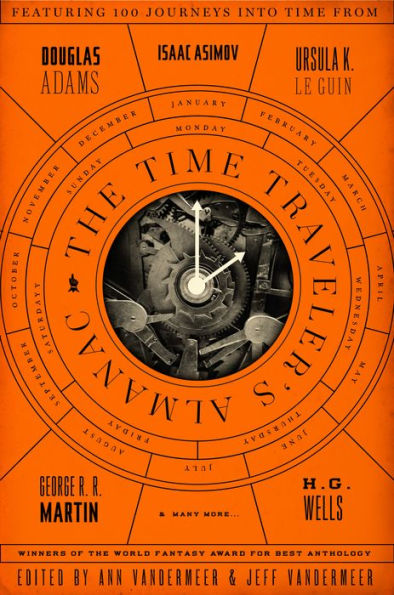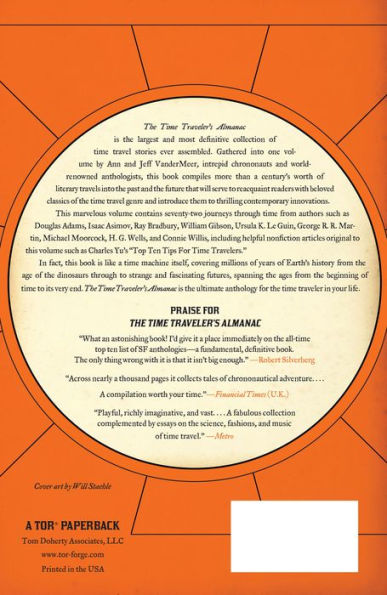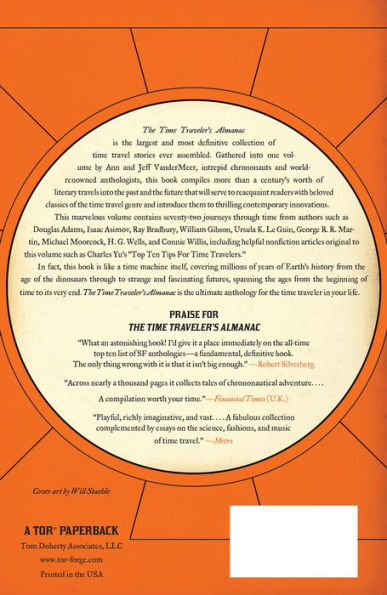Time travel is one of those science fictional tropes or "power chords" (to use the handy and vivid term deployed first by author Rudy Rucker) whose bedrock incorporation into a genre that supposedly values scientific credibility above all else gives lie to that very assertion of Newtonian fealty. The SF genre, of course, is really an organically evolved, marketplace- determined, idiosyncratic grab bag of themes and signifiers and characters and icons and gadgets, some of which hew to the realistic parameters and paradigms embraced by science, others of which partake more of fantasy and magic. Science offers no brief for the telekinetic powers of Darth Vader and hardly any greater justification for the faster-than-light travel that makes his empire possible. And yet what is Star Wars if not pure quill SF?
In a similar fashion, the science fiction genre without time travel stories would be unthinkable, a shadow of itself, despite the fact that most physicists hold out little hope of any practical means of time travel. Yes, a few experts, such as Michio Kaku and Paul Davies, have gone through a contortionist's efforts to justify it. But their exotic, Stage-3-Civilization-on-the-Kardashev-Scale, stellar-sized wormhole technology never seems to figure in most tales.
And so the motif of transcending the fourth dimension, journeying up and down and laterally across the river of time, sowing paradoxes left and right, shaking hands with Adam and Eve, killing Hitler, saving JFK, and witnessing the Crucifixion, is woven into the very weft of the genre, thanks in large early part to the massive influence of the very first novel from the pen of one of the field's founding fathers: H. G. Wells's The Time Machine. Since that landmark, any number of SF novels have played with the trope in many astonishing ways. Jack Williamson's The Legion of Time. Isaac Asimov's The End of Eternity. Poul Anderson's Time Patrol. David Gerrold's The Man Who Folded Himself. Connie Willis's duology, Blackout and All Clear. This list of book-length explorations could be multiplied a hundredfold.
But curiously enough, as we learn from the preface to The Time Traveler's Almanac by editors Ann and Jeff VanderMeer, despite the importance of time travel in the canon, there has never been a definitive collection of stories illustrative of this power chord. Well, if anyone can assemble such a book, it's the husband-and-wife team who compiled The Weird, a similar enjoyable, enlightening, and encyclopedic genre- defining effort. And certainly the editors have pulled out all the stops here, including seventy-two stories, from classic to newly hatched, as well as a variety of nonfiction.
They distinguish four types of tale: "Experiments;" "Reactionaries and Revolutionaries;" "Mazes and Traps;" and "Communiqués." It's a useful taxonomy that makes it all the easier to spot the standouts in the collection and the various ways in which they make the notion of breaking the bonds of temporality so alluring.
The stories in "Experiments" concern themselves with nascent technology: the time travel gadget is newly discovered and dicey. Naturally, this state of affairs often leads to tragedy. Ursula K. Le Guin's "Another Story..." delivers just such a lesson, where the author's trademark intimate world building makes the reader's empathy with the fate of the history-stranded protagonist all the more intense. Michael Moorcock's "Pale Roses," by contrast, brings an element of farce into the picture, with its decadent End of Time fops and hopeful monsters. Perhaps Michael Swanwick's "Triceratops Summer," marked by a bittersweet blend of promise and loss, hits the perfect stance between upbeat and downbeat.
We encounter also in this section William Gibson's "The Gernsback Continuum," which immediately raises an interesting distinction. Gibson's well-known story finds its narrator getting a glimpse of a future that never was, an alternate time stream. Strictly speaking, visits to alternate branches of the multiverse have historically constituted another subgenre entirely, the parallel universe tale, distinct from time travel per se. But since some current theories hold that any travel to the past would instantly result in a fresh forking of the multiverse, I think the editors are on solid ground in including such borderline tales, especially those that are, like Gibson's, particularly concerned with visions of futurity itself.
The stories in "Reactionaries and Revolutionaries" involve tinkering with the past. And the VanderMeers launch with a double-barreled blast of perfection: Ray Bradbury's "A Sound of Thunder" (in which a vital butterfly bites the dust) and "Vintage Season," by Henry Kuttner and Catherine Moore, where perverse cross-time disaster tourism is evoked with aching precision. And although there's nothing from Fritz Leiber's famous and influential "Changewar" series, the rest of the candidates are outstanding.
Harry Turtledove's "Forty, Counting Down" exquisitely embodies that eternally fascinating notion of going back in time to counsel your younger self. George R. R. Martin's "Under Siege" shows us that time travel need not be a physical process but possibly a mental one, à la Avatar. In Garry Kilworth's "On the Watchtower at Plataea" we witness science fiction approaching the lineaments of the pure historical novel, so well rendered and intense are the period details of the story. "This Tragic Glass" by Elizabeth Bear handily invokes the catchy notion of plucking famous figures out of their home era: in this case, the playwright Kit Marlowe.
The notion of logical paradoxes derived from chronal shenanigans underpins "Mazes and Traps." We open with a true milestone, the very first time travel story, anticipating even Wells. From 1881, Edward Page Mitchell's "The Clock That Went Backward" remains readable and unpredictable. When followed by the giddy existential romp that is Theodore Sturgeon's "Yesterday Was Monday," the section is off to a rollicking start.
The other highlights in this vein include Barrington Bayley's "Life Trap," which complicates the great theme of time reversal, à la The Curious Case of Benjamin Button; Greg Egan's "Lost Continent," which conflate conquerors out of time with the more familiar military crisis in Afghanistan; and Norman Spinrad's "The Weed of Time," which brings a mystical sense of eternity to the whole concept of duration.
But above all resides David Masson's "Traveller's Rest." I first read this surreal, highly charged story about war and peace and thwarted dreams over forty years ago, and am happy to report that it remains the masterpiece of well-engineered thought and feeling that I recalled.
Naturally enough, the stories in "Communiqués" concern themselves with messages across the years, sent up or down the time stream. It's rewarding to see Isaac Asimov given the lead position with "What If," showing the Good Doctor proficient in domestic drama as well as pangalactic psychohistory. Tanith Lee evokes a kind of classic noir feel with the appropriately titled "As Time Goes By" and its setting of a still point in the midst of contesting timelines. The much-missed Bob Leman channels Jerome Bixby and Ray Bradbury in his "Loob," about a simpleton with uncanny powers.
Harry Turtledove gives us the companion piece to his earlier story, "Twenty-One, Counting Up." Nalo Hopkinson's communiqué from the future takes a highly unexpected biological form in "Message in a Bottle." Adam Roberts proves himself again the master of the Unique High Concept with "The Time Telephone." Molly Brown offers very funny romantic hijinks with her "Bad Timing." And Charles Stross closes out the volume with a Stapledonian exercise dubbed "Palimpsests."
But the highlight in this section for me was "In the Tube," by the Edwardian writer E. F. Benson. A truly potent tale, meticulously crafted and just long enough, it superbly evokes the melancholy and fatedness of the quality we call time, and the limits of human perception and accomplishment.
After chrono-journeying with immense pleasure through this exemplary, illuminating and fascinating anthology, the veteran reader might still question the absence of one essential piece — Robert Heinlein's " — All You Zombies — ."Anyone in possession of a working time machine is hereby urged to make the trip back to the date upon which this magnificent compilation was being conceived, with the mission to ensure that this seminal work isn't left stranded in yesterday.
Author of several acclaimed novels and story collections, including Fractal Paisleys, Little Doors, and Neutrino Drag, Paul Di Filippo was nominated for a Sturgeon Award, a Hugo Award, and a World Fantasy Award — all in a single year. William Gibson has called his work "spooky, haunting, and hilarious." His reviews have appeared in The Washington Post, Science Fiction Weekly, Asimov's Magazine, and The San Francisco Chronicle.
Reviewer: Paul Di Filippo








